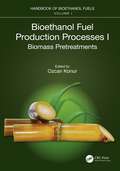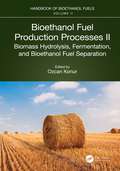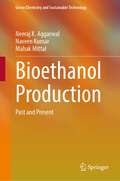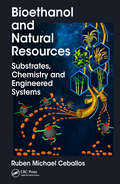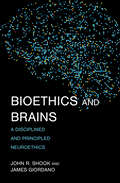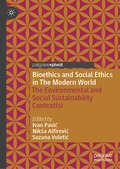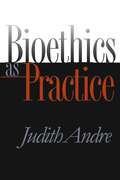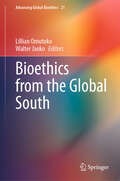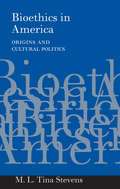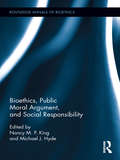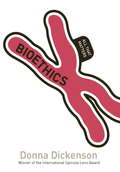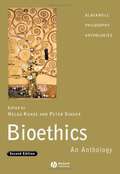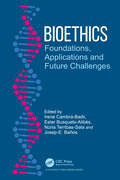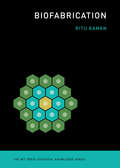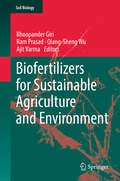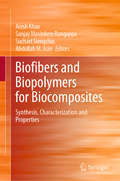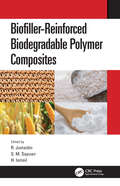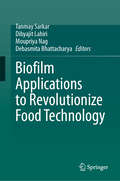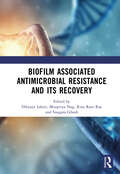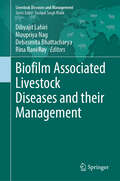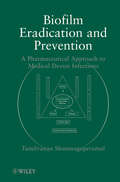- Table View
- List View
Bioethanol Fuel Production Processes. I: Biomass Pretreatments
by Ozcan KonurThis book presents research on biomass pretreatments, which are a fundamental part of bioethanol fuel production to make biomass more accessible. This book also includes an introductory section on the bioethanol fuels. Bioethanol Fuel Production Processes. I: Biomass Pretreatments is the first volume in the Handbook of Bioethanol Fuels (Six-Volume Set). The primary pretreatments at the macro level are the biological chemical, hydrothermal, and mechanical pretreatments of the biomass. It also has an introductory section on the biomass pretreatments at large for bioethanol fuel production. The major pretreatments at the micro level are the enzymatic and fungal pretreatments of the biomass as the biological pretreatments, acid, alkaline, ionic liquid, and organic solvent pretreatment pretreatments of the biomass as the chemical pretreatments, steam explosion and liquid hot water pretreatments of the biomass as the hydrothermal pretreatments, and milling, ultrasonic, and microwave pretreatments of the biomass as the mechanical pretreatments. The first volume also indicates that a wide range of pretreatments stand alone or in combination with each other fractionate the biomass to its constituents of cellulose, lignin, and hemicellulose and improve both sugar and bioethanol fuel yield, making this bioethanol fuel more competitive in relation to crude oil- and natural gas-based fossil fuels. This first volume is a valuable resource for the stakeholders primarily in the research fields of energy and fuels, chemical engineering, environmental science and engineering, biotechnology, microbiology, chemistry, physics, mechanical engineering, agricultural sciences, food science and engineering, materials science, biochemistry, genetics, molecular biology, plant sciences, water resources, economics, business, management, transportation science and technology, ecology, public, environmental and occupational health, social sciences, toxicology, multidisciplinary sciences, and humanities among others.
Bioethanol Fuel Production Processes. II: Biomass Hydrolysis, Fermentation, and Bioethanol Fuel Separation
by Ozcan KonurThis book provides an overview of the research on production processes for bioethanol fuels in general, hydrolysis of the pretreated biomass for bioethanol production, microbial fermentation of hydrolysates and substrates with yeasts for bioethanol production, and separation and distillation of bioethanol fuels from the fermentation broth, complementing the research on biomass pretreatments presented in the first volume. It presents an overview of the research on biomass hydrolysis in general, wood hydrolysis, straw hydrolysis, and cellulose hydrolysis for bioethanol fuel production in the first section for biomass hydrolysis. It provides an overview of the research on microbial hydrolysate fermentation for bioethanol production in general, alternative fermentation processes for bioethanol fuel production such as simultaneous saccharification and fermentation (SSF) and consolidated biomass processing (CBP) compared with the separate hydrolysis and fermentation (SHF) process, metabolic engineering of microorganisms and substrates for bioethanol fuel production, and utilization of Saccharomyces cerevisiae for microbial fermentation of hydrolysates for bioethanol fuel production in the second section for hydrolysate fermentation. It provides an overview of the research on the bioethanol fuel separation from the fermentation broth in the last section. This book is a valuable resource for the stakeholders primarily in the research fields of energy and fuels, chemical engineering, environmental science and engineering, biotechnology, microbiology, chemistry, physics, mechanical engineering, agricultural sciences, food science and engineering, materials science, biochemistry, genetics, molecular biology, plant sciences, water resources, economics, business, management, transportations science and technology, ecology, public, environmental and occupational health, social sciences, toxicology, multidisciplinary sciences, and humanities among others.
Bioethanol Production: Past and Present (Green Chemistry and Sustainable Technology)
by Naveen Kumar Neeraj K. Aggarwal Mahak MittalThis book provides the latest research on bioethanol production from first- and second- generation feedstock. Bioethanol has emerged as one of the main alternative biofuels in recent years. The book provides a perspective on the chemistry, sources and production of bioethanol highlighting the recent developments in the field.Through this book readers will learn basic and advanced bioethanol production technologies under one roof, including resource management and environmental and economic impacts. The topics discussed in the book will attract researchers and scholars focusing in this field as well as anyone who is interested in green and sustainable energy resources.
Bioethanol and Natural Resources: Substrates, Chemistry and Engineered Systems
by Ruben Michael CeballosBioethanol and Natural Resources: Substrates, Chemistry and Engineered Systems provides a comprehensive review of feedstocks, physiochemical and biological pretreatments, molecular substrates, cellulolytic and ligninolytic enzymes, and advanced technologies for producing bioethanol. Although this book provides a review of first-generation bioethanol feedstocks, chemistry, and processes, there is an emphasis on second-generation "cellulosic" ethanol production. With rapid advances in biofuels technologies and the continued global dependency on unsustainable extraction of fossil fuels, this text is timely. Although it is intended to be used as a supplemental text for advanced undergraduate or graduate level courses, the book is accessible to a non-academic audience. This book provides a unique opportunity to understand bioethanol production from the basic concepts and processes to the most cutting-edge technologies under development.
Bioethanol: A Green Energy Substitute for Fossil Fuels (Green Energy and Technology)
by Eriola Betiku Mofoluwake M. IsholaThis book looks deeply into the prospects for using ethanol as a greener alternative to fossil fuels and the technical and scientific issues that surround them. Ethanol, with its numerous advantages, has emerged as a promising contender to replace gasoline as a fuel source. Currently, it is commercially available as a blend with gasoline, commonly known as E10 and E25, utilizing various ratios of ethanol. Despite its clear benefits over gasoline, the widespread adoption of ethanol as a fuel remains hindered by its limited availability. In this insightful book, we aim to explore the multifaceted challenges surrounding ethanol's full integration into our energy landscape, employing a comprehensive approach through review manuscripts. Leading worldwide experts, known for their deep understanding of ethanol as a fuel, have contributed to the book. Their valuable insights and contributions enrich the book's content, offering readers a comprehensive exploration of the subject matter. This book is a compelling resource for researchers, energy professionals, and anyone interested in understanding the challenges and opportunities associated with the integration of ethanol as a substitute for gasoline.
Bioethics and Brains: A Disciplined and Principled Neuroethics (Basic Bioethics)
by John R. Shook James GiordanoHow neuroethics can be increasingly relevant and informative for inclusive social policy and political discourse about brain science and technologies.Neuroethics, a field just over two decades old, addresses both ethical issues generated in and by brain sciences and the neuroscientific studies of moral and ethical thought and action. These foci are reciprocally interactive and prompt questions of how science and ethics can and should harmonize. In Bioethics and Brains, John R. Shook and James Giordano ask: How can the brain sciences inform ethics? And how might ethics guide the brain sciences and their real-world applications?The authors&’ structure for a disciplined neuroethics reconciles science and ethics by requiring ethical principles consistent with moral neuroscience and moral psychology. Their cosmopolitan perspective looks beyond Western theories toward a new metaethics for neuroethics and illustrates its approach in chapters that address the issues and approaches to questions and problems generated by the proliferation of neurotechnology in global contexts. Shook and Giordano posit that neuroethics can merge science and ethics toward establishing global consensus on guiding brain research, neurotechnological innovation, and grounding neurorights.
Bioethics and Social Ethics in The Modern World: The Environmental and Social Sustainability Context(s)
by Nikša Alfirević Ivan Pavić Suzana VuletićThis book explores the philosophical analysis of attitudes and values and sustainable behaviors in fields such as healthcare, social sciences, economics in the context of environmental studies. It firstly investigates the fundamental concept of bioethics with relevant case studies related to the issues of human life and preservation of dignity. The authors then move on to discuss the application of (bio)ethical principles in contemporary society and within the market economy. The last part of the book brings together a variety of perspectives on the general philosophical and ethical foundations of sustainable behavior based on the idea of human dignity. This book offers a guide to understanding responsible sustainability practices in various fields, while considering the social benefits and economic effectiveness of sustainable behaviors.
Bioethics as Practice
by Judith Andre<P>Those who work in bioethics and the medical humanities come from many different backgrounds, such as health care, philosophy, law, the social sciences, and religious studies. The work they do also varies widely: consulting on ethical issues in patient care, working with legislatures, dealing with the media, teaching, speaking, writing and more. <P>Writing as a participant in this developing field, Judith Andre offers a model to unify its diversity. Using the term "bioethics" broadly, to include all the medical humanities, she articulates ideals for the field, identifies its temptations and moral pitfalls, and argues for the central importance of certain virtues. Perhaps the most original of these is the virtue of choosing projects well, which demands not only broadening the field's focus but also understanding the forces that have kept it too narrow. Andre offers an imaginative analysis of the special problems presented by interdisciplinary work and discusses the intellectual virtues necessary for its success. She calls attention to the kinds of professional communities that are necessary to support good work. <P>The book draws from interviews with many people in the field and from the findings of social scientists. It includes the author's personal reflections, several extended allegories, and philosophical analysis. <P>Those who work in bioethics and the medical humanities come from many different backgrounds: health care, philosophy, law, social sciences, religious studies, and more. The work they do also varies widely. Writing as a participant in this developing field, Judith Andre offers a model to unify its diversity. Using the term "bioethics" broadly, to include all the medical humanities, she articulates ideals for the field, identifies its temptations and moral pitfalls, and argues for the central importance of certain virtues.-->
Bioethics from the Global South (Advancing Global Bioethics #21)
by Lillian Omutoko Walter JaokoThis book tackles complex global issues like vaccination, climate change, environmental ethics, embryo adoption, and surrogate motherhood viewed from the perspective of the global south. The COVID-19 pandemic has emphasized the need for addressing bioethical issues on a global scale, beyond national and regional boundaries. Challenges highlighted in the book include cultural differences, multi-pluralism, insufficient funding, and limited opportunities for awareness and provision of education in global bioethics, particularly in low and middle-income countries. The book employs universal and global bioethics frameworks, referencing the Universal Declaration of Human Rights and the UNESCO Universal Declaration on Bioethics and Human Rights. These documents, along with other international agreements and national constitutions were used to advocate for human dignity, health, and fundamental freedoms. Contributions from authors in Kenya, Uganda, and Nigeria provide valuable perspectives, making this book a must-read for ethicists, bioethicists, medical students, and healthcare workers with an interest in global bioethics.
Bioethics in America: Origins and Cultural Politics
by M. L. StevensIn Bioethics in America, Tina Stevens challenges the view that the origins of the bioethics movement can be found in the 1960s, a decade mounting challenges to all variety of authority. Instead, Stevens sees bioethics as one more product of a "centuries-long cultural legacy of American ambivalence toward progress," and she finds its modern roots in the responsible science movement that emerged following detonation of the atomic bomb.Rather than challenging authority, she says, the bioethics movement was an aid to authority, in that it allowed medical doctors and researchers to proceed on course while bioethicists managed public fears about medicine's new technologies. That is, the public was reassured by bioethical oversight of biomedicine; in reality, however, bioethicists belonged to the same mainstream that produced the doctors and researchers whom the bioethicists were guiding.
Bioethics, Public Moral Argument, and Social Responsibility (Routledge Annals of Bioethics)
by Nancy M. P. King Michael J. HydeBioethics, Public Moral Argument, and Social Responsibility explores the role of democratically oriented argument in promoting public understanding and discussion of the benefits and burdens of biotechnological progress. The contributors examine moral and policy controversies surrounding biomedical technologies and their place in American society, beginning with an examination of discourse and moral authority in democracy, and addressing a set of issues that include: dignity in health care; the social responsibilities of scientists, journalists, and scholars; and the language of genetics and moral responsibility.
Bioethics: All That Matters
by Donna DickensonIn this book:Donna Dickenson - Winner of the International Spinoza Lens AwardShould we do what ever science lets us do?Bioethics: All That Matters, new developments in biotechnology like genetics, stem cell research and artificial reproduction arouse both our greatest hopes and our greatest fears. Many people invest the new biotechnology with all the aspirations and faith once accorded to religious salvation. But does everyone benefit equally from scientific progress? Commercialised modern biomedicine runs the risk of exploiting vulnerable groups, from Indian 'surrogate' mothers to professional guinea pigs in drug research. Professor Dickenson argues that although we've entered new scientific territory, there's no need to jettison our existing moral sense. By discussing a range of real-life cases, she equips readers to make up their own minds on these important and controversial questions. Good science and good ethics needn't be contradictory.This accessible and concise book will appeal to both students and general readers, giving a fascinating introduction to a wide range of perspectives on Bioethics.All That Matters books:All books in the All That Matters series are written by world experts in their subject field. These experts work to distil a topic and get right to its heart, making the book accessible for both students and general readers. Each compelling book contains new and interesting perspectives and tells stories that matter.The Author:All That Matters - Interesting introductions to important issuesBooks on the following subjects are available from the All That Matters series: Muhammad, God, Water, Political Philosophy, Sustainability, Philosophy, Intelligence, Love, Russian Revolution, War, and Creativity.To find out more visit: www.allthatmattersbooks.com
Bioethics: An Anthology (Second Edition)
by Peter Singer Helga KuhseThe expanded and revised edition of Bioethics: An Anthology is a definitive one-volume collection of key primary texts for the study of bioethics. Brings together writings on a broad range of ethical issues relating such matters as reproduction, genetics, life and death, and animal experimentation. Now includes introductions to each of the sections. Features new coverage of the latest debates on hot topics such as genetic screening, the use of embryonic human stem cells, and resource allocation between patients. The selections are independent of any particular approach to bioethics. Can be used as a source book to complement A Companion to Bioethics (1999).
Bioethics: An Introduction for the Biosciences
by Ben MephamBioethical issues remain front-page news, with debate continuing to rage over issues including genetic modification, animal cloning, and 'designer babies'. With public opinion often driven by media speculation, how can we ensure that informed decisions regarding key bioethical issues are made in a reasoned, objective way? Bioethics: An Introduction for the Biosciences offers a balanced, objective introduction to the field of bioethics, ideal for any biosciences student who is new to the subject. With a focus on developing the students' power of reasoning and judgement, the book presents different perspectives to common themes in an impartial way, fostering debate and discussion. The opening section, 'The Ethical Groundwork', introduces students to the nature of bioethics and ethical theory. The book goes on to lead students through a broad range of bioethical issues relating to people, animals, and food, before concluding with an overview of bioethics in practice. The current generation of students will become the next generation of decision makers. Bioethics: An Introduction for the Biosciences is the perfect introduction to a field with which every biosciences student should be familiar. Online Resource Centre The Online Resource Centre features: For registered adopters of the book: - Figures from the book in electronic format, ready to download For students: - A web link library and hyperlinked reference list, giving ready access to additional information sources; - Topical updates: extensive summaries of the latest developments in those topics covered in the book, ensuring that the reader can remain up-to-date at all times.
Bioethics: Foundations, Applications and Future Challenges
by Irene Cambra-Badii Ester Busquets-Alibés Terribas-Sala Núria Josep-E. BañosThe aim of this book is to introduce and discuss bioethics in a three-synergistic way: from the foundations to the current debates in relation to healthcare and social bioethics, and thereafter the possible future challenges. In this sense, the target audience can be from diverse disciplines: life and medical sciences, law, philosophy, psychology, and education. The book will be useful to high school students, in their first contacts with bioethics, college students, teachers and researchers, and the general public interested in these controversial debates of the past, present and future of bioethics.
Biofabrication (The MIT Press Essential Knowledge series)
by Ritu RamanHow engineered materials and machines powered by living biological cells can tackle technological challenges in medicine, agriculture, and global security.You are a biological machine whose movement is powered by skeletal muscle, just as a car is a machine whose movement is powered by an engine. If you can be built from the bottom up with biological materials, other machines can be as well. This is the conceptual starting point for biofabrication, the act of building with living cells--building with biology in the same way we build with synthetic materials. In this volume in the MIT Press Essential Knowledge series, Ritu Raman offers an accessible introduction to biofabrication, arguing that it can address some of our greatest technological challenges. After presenting the background information needed to understand the emergence and evolution of biofabrication and describing the fundamental technology that enables building with biology, Raman takes deep dives into four biofabrication applications that have the potential to affect our daily lives: tissue engineering, organs-on-a-chip, lab-grown meat and leather, and biohybrid machines. Organs-on-a-chip (devices composed of miniature model tissues), for example, could be used to test new medicine and therapies, and lab-grown meat could alleviate environmental damage done by animal farming. She shows that biological materials have abilities synthetic materials do not, including the ability to adapt dynamically to their environments. Exploring the principles of biofabrication, Raman tells us, should help us appreciate the beauty, adaptiveness, and persistence of the biological machinery that drives our bodies and our world.
Biofabrication for Orthopedics: Methods, Techniques and Applications
by Xin Zhao Wenguo Cui Shen LiuBiofabrication for Orthopedics A comprehensive overview of biofabrication techniques for orthopedics and their novel applications With an ever-increasing global population and the rise in the occurrence of orthopedic diseases amongst an aging population, it is essential for technological advances to meet this growing medical need. Orthopedic biofabrication is a cutting-edge field that seeks to produce novel clinical solutions to this mounting problem, through the incorporation of revolutionary technologies that have the potential to not only transform healthcare, but also provide highly automated and personalized patient solutions. With the advances in the discipline, there is a significant growing interest in biofabrication for orthopedics in research activity geared towards routine clinical use. Ideal for a broad readership amongst medical practitioners and scientists, Biofabrication for Orthopedics summarizes all aspects of the topic: detailed information on the technology, along with advanced developments, research progress, and future perspectives on biofabrication for orthopaedics—particularly on the potential applications for tissue engineering technologies. In doing so, the book describes the various biomaterials—natural and synthetic—use for orthopedics and discusses the many ways in which these materials can be used in all parts of the body. As such, it offers detailed information on a wide range of applications in the fields of biology and clinical and industrial manufacturing. Biofabrication for Orthopedics readers will also find: Insights into the applications of biofabrication technologies in various bodily functions Thorough discussion of different biofabrication techniques used in creating orthopedic products, like stereolithography, cell sheet and organ bioprinting, electrospinning, and microfluidics Discussion of a wide range of diverse functions, such as bone implants, skin regeneration, vascularization, meniscus remodeling, and more Biofabrication for Orthopedics is a useful reference for those in a variety of research fields like medical-related practitioners and scientists, materials science, medicine, and manufacturing, as well as the libraries who support them.
Biofertilizers for Sustainable Agriculture and Environment (Soil Biology #55)
by Ajit Varma Ram Prasad Qiang-Sheng Wu Bhoopander GiriThis book provides a comprehensive overview of the benefits of biofertilizers as an alternative to chemical fertilizers and pesticides.Agricultural production has increased massively over the last century due to increased use of chemical fertilizers and pesticides, but these gains have come at a price. The chemicals are not only expensive; they also reduce microbial activity in agricultural soils and accumulate in the food chain, with potentially harmful effects for humans. Accordingly, it is high time to explore alternatives and to find solutions to overcome our increasing dependence on these chemicals.Biofertilizers, which consist of plant remains, organic matter and microorganisms, might offer an alternative. They are natural, organic, biodegradable, eco-friendly and cost-effective. Further, the microbes present in the biofertilizers are important, because they produce nutrients required for plant growth (e.g., nitrogen, phosphorus, potassium), as well as substances essential for plant growth and development (e.g., auxins and cytokinins). Biofertilizers also improve the physical properties, fertility and productivity of soil, reducing the need for chemical fertilizers while maintaining high crop yield. This makes biofertilizers a powerful tool for sustainable agriculture and a sustainable environment.The book covers the latest research on biofertilizers, ranging from beneficial fungal, bacterial and algal inoculants; to microbes for bioremediation, wastewater treatment; and recycling of biodegradable municipal, agricultural and industrial waste; as well as biocontrol agents and bio-pesticides. As such, it offers a valuable resource for researchers, academics and students in the broad fields of microbiology and agriculture.
Biofertilizers for Sustainable Soil Management
by Shah Fahad Muhammad Adnan Shah Saud Fazli WahidThe alkaline calcareous nature, high pH, salinity, heavy metals pollution, and low organic matter content of soils in many parts of the world have diminished the soil fertility and made essential nutrients unavailable to crops. To cope with the poor availability of soil nutrients, improve soil health, and feed the fast-growing global population, the farming community is using millions of tons of expensive chemical fertilizers in their fields to maintain an adequate level of nutrients for crop sustainability as well as to ensure food security. In this scenario, the exploitation of biofertilizers has become of paramount importance in the agricultural sector for their potential role in food safety and sustainable crop production. Bearing in mind the key importance of biofertilizers, this book examines the role of biofertilizers in sustainable management of soil and plant health under different conditions of the changing climate. Finally, it provides a platform for scientists and academicians all over the world to promote, share, and discuss various new issues, developments, and limitations in biofertilizers, crops, and beneficial microbes. Salient Features: Mainly focuses on the role of biofertilizers in managing soils for improving crop and vegetable yields as a substitute for chemical fertilizers. Highlights the valuable information for the mechanism of action, factors affecting, and limitations of biofertilizers in the wider ecosystem. Presents a diversity of techniques used across plant science. Designed to cater to the needs of researchers, technologists, policy makers, and undergraduates and postgraduates studying in the fields of organic agriculture, soil microbiology, soil biology, soil fertility, and fertilizers. Addresses plant responses to biofertilizers.
Biofibers and Biopolymers for Biocomposites: Synthesis, Characterization and Properties
by Abdullah M. Asiri Anish Khan Suchart Siengchin Sanjay Mavinkere RangappaThis book summarizes recent developments in epoxy blends. It emphasizes new challenges for the synthesis, characterization, and properties of biofibers and biopolymers. It provides updates on all the important areas of biofibers and biopolymers in a comprehensive fashion, including synthesis, processing, characterisation and application. It provides a a one-stop reference for researchers and those working in industry and government. The book correlates macro, micro and nanostructure properties. Moreover, it provides cutting edge research from experts around the globe. The current status, trends, future directions and opportunities are discussed in detail, making the book also accessible for beginners to the subject and young researchers.
Biofiller-Reinforced Biodegradable Polymer Composites
by R. JumaidinPresenting a comprehensive overview of the field, Biofiller-Reinforced Biodegradable Polymer Composites examines biodegradable composites derived from biofiller and biodegradable polymers while providing critical information for efficient use of biocomposites developed from natural resources. Discusses advanced techniques for the use of both biofiller and biodegradable polymers as the matrix for composites. Highlights application of both natural fiber and natural matrix for composites in the development of environmentally friendly and sustainable materials. Introduces the basics of biocomposites, the processing and characteristics of new composite materials, and new combinations of composites such as soy protein and nanocellulose. Elaborates on the introduction of new materials to develop biodegradable polymers. This book has been written for researchers, advanced students, and professional engineers and materials scientists working in the area of bio-based polymers, natural fiber composites, and biocomposites.
Biofilm Applications to Revolutionize Food Technology
by Moupriya Nag Dibyajit Lahiri Tanmay Sarkar Debasmita BhattacharyaBiofilm Applications to Transform the Food Industry is a sweeping introduction to the world of biofilms, illuminating their potential to revolutionize the landscape of both food safety and culinary innovation. This groundbreaking work delves into the various methods through which biofilms improve quality and sensory aspects, while also enhancing overall safety and sustainability. At its core, this book addresses the preeminent challenge facing the food industry: how to optimize taste, enhance safety and extend shelf life without compromising nutritional value. It offers a dynamic blueprint for chefs, food scientists, and industry professionals to leverage biofilm usage, exploring cutting-edge techniques that revolutionize fermentation, flavor enhancement, and waste reduction. By decoding the intricate mechanisms of biofilm interactions, this work unveils solutions to persistent industry challenges, providing practical insights and strategies to elevate culinary experiences while meeting consumer demands for healthier, safer, and more flavorful foods. Biofilm Applications to Transform the Food Industry is an indispensable guide for culinary professionals, food technologists, and enthusiasts seeking to stay ahead in a rapidly evolving industry. It equips readers with the tools to navigate the complexities of biofilm applications, empowering them to innovate, create ethically sound products, and contribute to a more sustainable future. This title's relevance lies in its ability to bridge the gap between cutting-edge science and practical culinary applications, making it an essential resource for those passionate about shaping the future of food technology.
Biofilm Associated Antimicrobial Resistance and Its Recovery
by Rina Rani Ray Moupriya Nag Dibyajit Lahiri Sougata GhoshA biofilm is a collection of microbial cells that have adhered to biotic surfaces such as plant cuticles or animal epithelia, as well as abiotic surfaces such as rocky substratum or catheter exteriors. The life cycle of a microorganism includes the fundamental process of biofilm formation for survival in diverse and harsh environments since it is a protected mode of growth allowing colonisation of new habitats by dispersal of microbes from the microbial clusters. The biofilm bound microorganisms remain embedded in an extracellular polymeric matrix that protects the indwelling cells from surfactants, biocides, several invaders like protozoans, and defences offered by the hosts like phagocytic cells. The biofilm bound recalcitrant microbes induce chronic and nosocomial diseases, posing a serious threat to public health. It has been observed that various antimicrobial drugs are able to successfully remove the planktonic (freely suspended) states of microbes as compared to the sessile (substrate-bound) forms, thus resulting in the development of antimicrobial resistance. Modern pharmacological strategies targeting the biofilm matrix differ from the conventional methods of antibiotic usage. This includes the use of natural compounds such as plant bioactive molecules, antimicrobial peptides, green synthesised nanoparticles, or secondary metabolites from other organisms that not only prevent the rise of antimicrobial resistance but are also safe for the host tissues. Biofilm Associated Antimicrobial Resistance and Its Recovery provides a detailed and systematic review of alternative pharmacological developments in the field of biofilm research. Features: A narrative overview of the mechanism of biofilm formation and its role in the emergence of antimicrobial resistance. Recent research in the development of antibiofilm remedies involving biogenic compounds. Advancements in biofilm detection methodologies with cutting-edge technologies. This book serves as a resource for researchers who need to understand and analyze the progression of events during microbial biofilm formation, as well as design safer methodologies for its successful eradication. It may also be used as a textbook for a graduate level course in microbiology or microbial biotechnology.
Biofilm Associated Livestock Diseases and their Management (Livestock Diseases and Management)
by Rina Rani Ray Moupriya Nag Dibyajit Lahiri Debasmita BhattacharyaThe book discusses biofilms and adherent communities of microorganisms that play a significant role in livestock-associated infections. It explores the characteristics, formation, and consequences of biofilms in various livestock species and explains their involvement in diseases like mastitis, Johne's disease, caseous lymphadenitis, and more. It also explains intricate aspects of biofilm-related challenges, such as virulence, antibiotic resistance, quorum sensing, and inter-species communication. The book then explores the strategies for combatting biofilm-associated infections, encompassing phytomedicines, novel antimicrobials, and nanomedicines. This book serves as a great resource for researchers, veterinary practitioners and students by addressing these critical issues and providing a comprehensive understanding of biofilm dynamics in livestock infections, fostering improved diagnosis and treatment methodologies.
Biofilm Eradication and Prevention
by Tamilvanan ShunmugaperumalBiofilm Eradication and Preventions presents the basics of biofilm formation on medical devices, diseases related to this formation, and approaches pharmaceutical researchers need to take to limit this problem. Split into three parts, the first deals with the development and characterization of biofilm on the surfaces of implanted or inserted medical devices. Questions as to why biofilms form over medical device surfaces and what triggers biofilm formation are addressed. In the second section, the author discusses biofilm-mediated chronic infections occurred in various organs (eyes, mouth, wounds) and pharmaceutical and drug delivery knowledge gained from research in these area. The third part explores pharmaceutical approaches like lipid-and polymer-based drug delivery carriers for eradicating biofilm on device-related infections. In addition, this section also explores the topic of novel small molecule (like iron and its complexes/metal chelators) and a quorum-sensing inhibitors to control medical biofilm formation.
